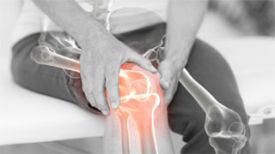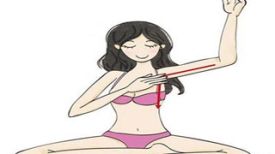
In core and lower back training, people usually focus on prominent large muscles, while some deep muscles such as the quadratus lumborum are also very important. The quadriceps muscle is a deep back muscle located between the iliac crest and the 12th rib in the upper pelvis, and can work independently or collaboratively on both sides. Its functions include spinal flexion, extension, and stabilization of the spine.
7 Best Lumbar Stretching Exercises:
1. Standing QL Stretching
This is the basic method for extending the quadratus lumborum muscle, which does not require equipment, has limited space, and is suitable for practicing after prolonged sitting.
Step: Stand straight, cross your left foot with your right foot, raise your left arm above your head, tilt your upper body to one side, push your hips to strengthen stretching, hold for 30-60 seconds, and switch to the other side.
Target muscles: mainly include the erector spinae, latissimus dorsi, and oblique muscles, followed by the erector spinae and rectus abdominis muscles.
Benefits: Easy to learn, spinal friendly, able to stretch the latissimus dorsi and quadratus lumborum muscles.
Tip: Pay attention to imbalanced flexibility and maintain a right angle between the hips and shoulders. Can be supported by the wall.
2. Door posture
This is a yoga practice aimed at multiple areas such as the lower back muscles, which can stretch and relax one side of the body's muscles.
Step: Kneel, stand upright with one foot extended, slide your arm, and tilt your body.
Target muscles: mainly include the erector spinae, latissimus dorsi, and oblique muscles, followed by the rectus abdominis and adductor muscles.
Benefits: Comfortable to stretch, adjustable according to flexibility, can relieve tension in the lower back and buttocks.
Tip: Kneel on the folding pad, increase stretch when exhaling, and relax the armpits.
3. Triangle style
This is another type of yoga stretching that involves the lumbar muscles, which can be performed while standing and is more challenging.
Step: Stand up, feet apart, right foot forward, left foot leaning outward, arms raised, right hip articulated, right hand on right leg, left arm facing up.
Target muscles: mainly include the erector spinae, latissimus dorsi, and oblique muscles, followed by the rectus abdominis and adductor muscles.
Benefits: Provides deep stretching for the quadriceps and other muscles without the need for cushions, facilitating position awareness and balance.
Tip: Adjust the width of the standing posture, use yoga tiles to reduce the pressure on the lower back, and do it barefoot on a non slip surface.
4. Sitting posture QL stretching
Suitable for people who sit for a long time without leaving their desk.
Step: Sit on the edge of the chair, bend your legs 90 degrees, raise your right arm above your head, and tilt to the left.
Target muscles: mainly include the erector spinae, latissimus dorsi, and oblique muscles, followed by the erector spinae and rectus abdominis muscles.
Benefits: Suitable for office workers and beginners, convenient for those with limited mobility.
Tip: It works well on a non wheeled chair, and can also sit on a bench or stool, or even cross legged on the ground.
5. Infant style
Can relax the spine and stretch lower back muscles such as the quadratus lumborum.
Step: Kneel down on all fours, sit with your hips on your heels, lower your chest, and extend your arms forward.
Target muscles: mainly the erector spinae, latissimus dorsi, and gluteus maximus.
Benefits: Gentle stretching of the lower back, relaxing and calming, suitable for those with mild tension or pain, and is a cooling exercise after exercise.
Tip: Kneel on the folding pad, breathe slowly, and try different knee positions.
6. Knee to chest extension exercise
Can gently stretch the lower back muscles such as the quadratus lumborum.
Step: Lie down, bend your legs, grab the back of your thighs, and pull your knees towards your chest.
Target muscles: mainly the erector spinae, latissimus dorsi, and gluteus maximus.
Benefit: Gentle and relaxing, suitable for those with poor health, relieving waist tension.
Tip: Keep your shoulders and upper back on the floor, and use a pillow or cushion for your head. Practice lifting with one leg.
7. Dynamic Standing QL Stretching
This is dynamic stretching, suitable for warm-up, and will not cause muscles to lose vitality.
Step: Stand with your feet shoulder width apart, slightly bend your knees, tilt your hand to the left, stand straight and repeat, then switch sides.
Target muscles: mainly the erector spinae, rectus abdominis, and hip abductor muscles.
Benefit: It is a good warm-up exercise, suitable for beginners and those with poor physical fitness.
Tip: Keep your knees slightly bent without twisting your hips and shoulders, and practice alternately.
Frequently Asked Questions:
How to isolate the quadratus lumborum muscle? Unable to isolate, it works in coordination with other muscles.
2. Stretching time: Maintain flexibility for 15-20 seconds, increase flexibility for 30-60 seconds, with one side shorter and the other longer depending on the situation.
3. Training the quadratus lumborum muscle will not make the waist thicker, but may actually make the waist tighter.
4. Exercise pain should be stopped immediately, and after checking the movements, try again. If the pain persists, skip or seek medical attention.
5. Determine whether to stretch or strengthen the quadratus lumborum muscle according to one's own needs. If there are no obvious problems, there may be no need for additional attention.
In short, the quadriceps muscle is important, stretching and strengthening are relatively simple, and many exercises can be completed at home. But before starting, it is necessary to determine whether it is necessary, and if so, choose a suitable practice method.


